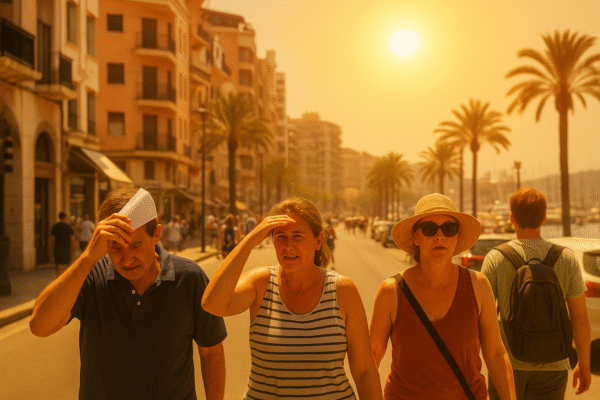Spain is facing one of the most intense heatwaves in recent memory, with rare red weather alerts issued for Alicante and Benidorm as temperatures push dangerously past 42°C. The sweltering conditions are impacting locals and visitors alike, raising serious concerns about public health, infrastructure, and the tourism industry during the peak of summer travel season.
Red Alerts in Spain’s Tourist Hubs
The Spanish Meteorological Agency issued red alerts across the southeastern regions, particularly in Alicante, Benidorm, and the Vega del Segura area, including Murcia. These warnings, reserved only for the most extreme weather conditions, highlight the severity of the heatwave gripping the country. From midday through the evening, authorities expect soaring temperatures to reach their peak, making outdoor activities highly risky.
Local health officials have urged people to avoid direct sunlight during midday hours, remain hydrated, and wear light, breathable clothing. Emergency services are on high alert, with hospitals bracing for an increase in cases of heatstroke, dehydration, and other heat-related illnesses.
Amber and Yellow Warnings Across Spain
Beyond the red alert zones, southern Spain, including Seville and Huelva, remains under amber alerts, where temperatures between 40°C and 42°C are forecast. These conditions pose significant risks for outdoor workers, children, and elderly residents, prompting local governments to mobilize cooling shelters and public awareness campaigns.
Meanwhile, central and northeastern Spain is experiencing slightly milder conditions but remains under yellow warnings. In these regions, forecasts predict highs in the upper 30s, which, while less extreme, still create health hazards for vulnerable populations and disrupt everyday routines.
Balearic Islands Strain Under Tourism and Heat
The **Balearic Islands—Ibiza, Formentera, and northern Majorca—**are also sweltering under amber heat alerts, with temperatures climbing close to 39°C. Known globally as top holiday destinations, these islands are now facing pressure on their tourism infrastructure. Hotels, resorts, and restaurants are working to provide safe, air-conditioned environments for visitors, but the surge in demand is stretching local resources.
Menorca, under a yellow alert with highs near 36°C, is slightly less affected but still contending with discomfort for travelers unaccustomed to Mediterranean heat. The tourism boards of the islands are advising visitors to plan beach trips in the morning or late afternoon while spending the hottest hours indoors.
Impact on Tourism Industry
Spain’s tourism sector, which thrives during the summer months, is being tested by this extreme heatwave. Alicante and Benidorm, typically bustling with international visitors, are seeing adjustments to daily itineraries as tourists avoid outdoor excursions, guided city tours, and midday beach activities. Many local businesses are adapting by extending evening operating hours when temperatures are more bearable, creating a shift in the tourism dynamic.
Despite the challenges, Spanish authorities emphasize that the country remains open for tourism but strongly urge travelers to take precautions. Tour operators are also adjusting schedules to prioritize safety, offering early morning sightseeing and late-evening cultural experiences while minimizing exposure during peak heat hours.
Relief in Sight
Meteorologists forecast that the worst of the heatwave will begin to ease by Tuesday, August 19, with showers and thunderstorms expected in northeastern regions near the Pyrenees. These storms may bring localized disruptions but also much-needed relief from the oppressive heat.
On the Mediterranean coast, including Valencia and Barcelona, temperatures are expected to decline slightly though conditions will remain warm. Majorca, however, is predicted to continue under a yellow alert, with temperatures peaking around 36°C. Authorities caution that while the intensity may decrease, the risks of sunstroke and dehydration remain, particularly for visitors unacquainted with Spain’s summer extremes.
Public Health and Safety Measures
The Spanish Ministry of Health has issued nationwide safety guidelines urging citizens and visitors to:
- Stay hydrated by drinking water regularly.
- Avoid alcohol and caffeinated drinks during peak heat hours.
- Stay indoors from 12 p.m. to 5 p.m. when temperatures are most dangerous.
- Use shaded areas, hats, and sunscreen for outdoor activities.
- Check regularly on elderly family members and children.
Cooling centers have been set up in major cities, while beach patrols are increasing vigilance to assist tourists affected by the heat.
A Warning for the Future
This extreme heatwave not only challenges Spain’s immediate tourism season but also raises broader concerns about climate resilience. Weather experts highlight that prolonged heat events are becoming more frequent across southern Europe, forcing the tourism industry to rethink strategies for visitor safety and sustainable travel planning.
Conclusion
Spain’s red alert heatwave has brought Alicante, Benidorm, and the Balearic Islands into sharp focus, as locals and tourists alike battle relentless temperatures exceeding 42°C. While relief is on the horizon, the impact on tourism, public health, and daily life underscores the growing reality of extreme weather events in Europe. For now, safety measures and careful planning remain key for anyone traveling through Spain’s sun-soaked regions this summer.
For more travel news like this, keep reading Global Travel Wire















